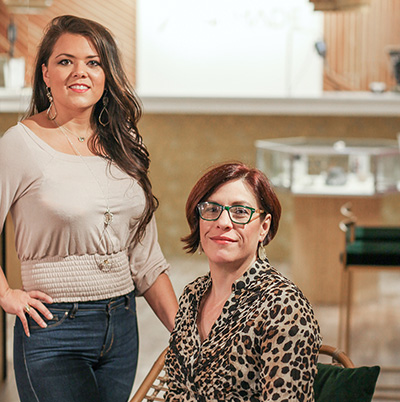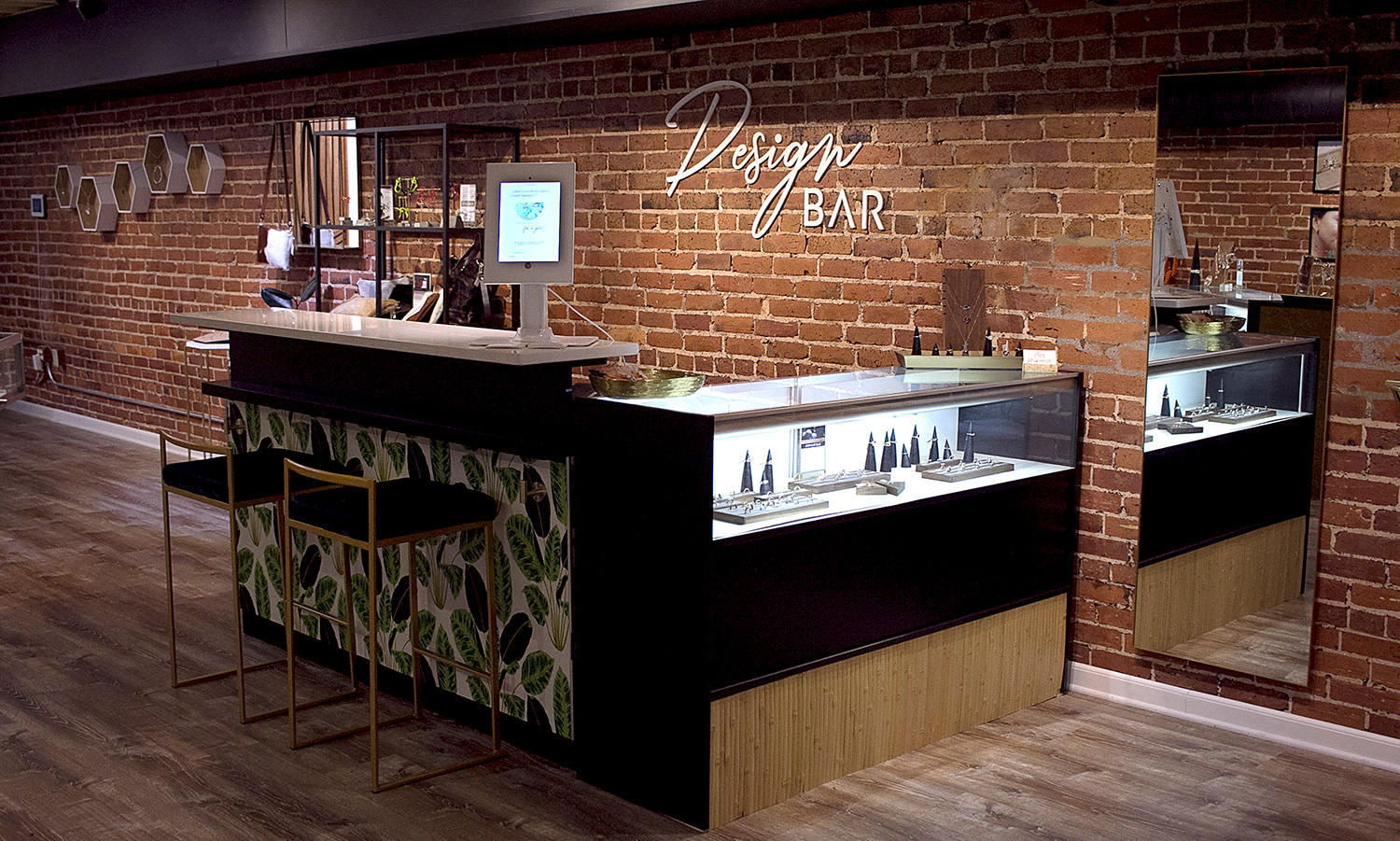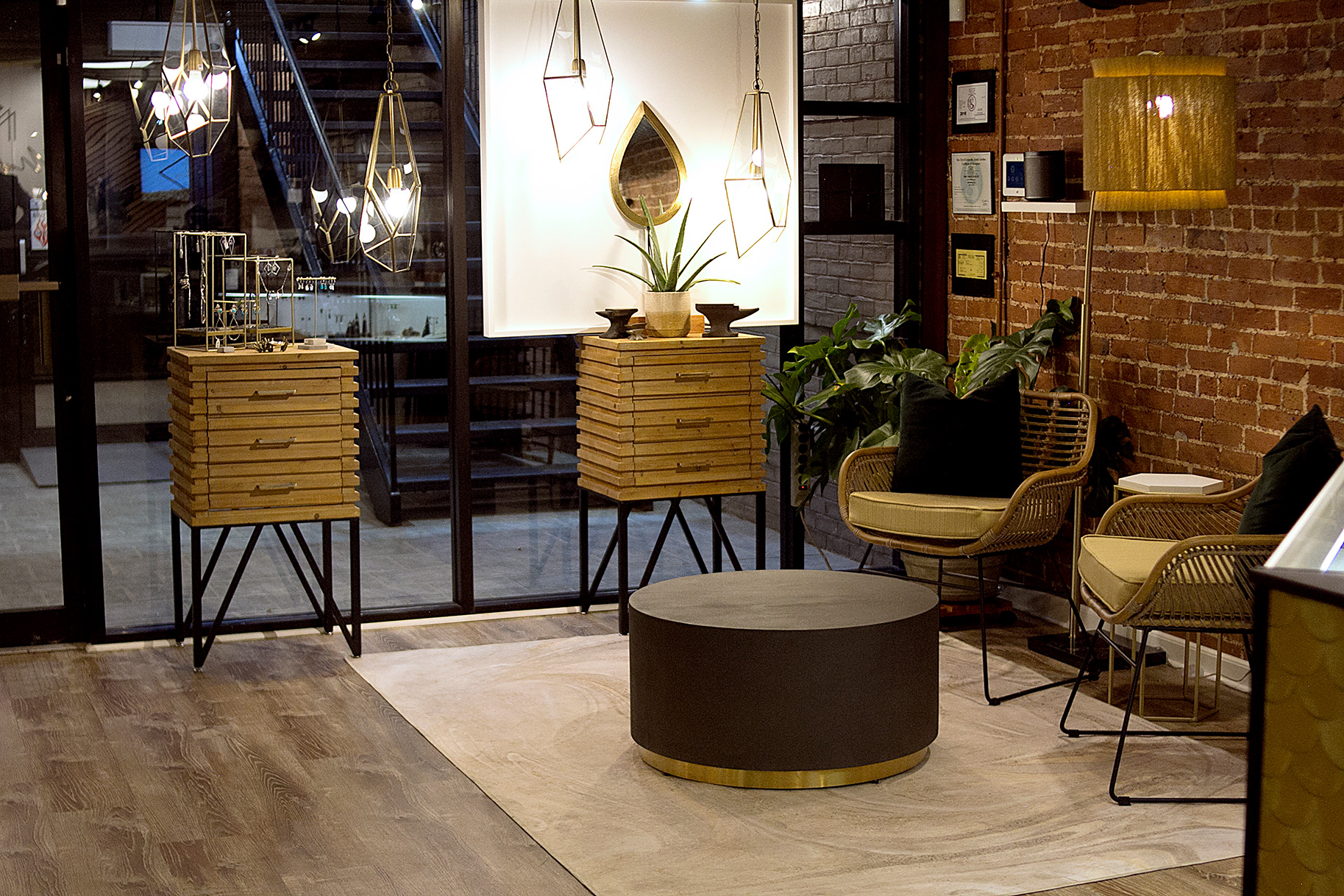MAKE MADE Jewelry, Greenville, SC
OWNERS: Katie Poterala and Danielle Miller Gilliam; URL:makemadejewelry.com; FOUNDED: 2018; ARCHITECT: Markalunas Architecture Group; Opened Featured Location: 2019; AREA: 2,000 sq. ft including 1,000 square foot showroom; BUILDOUT COST: $90,000

Katie Poterala and Danielle Miller Gilliam are jewelry artists and teachers.
WALLPAPERED CASES, BRICK walls and a working studio all set the tone for something different in Greenville, SC, and appeal to shoppers searching for jewelry as distinctive as the venue.
Owners and jewelry artists Katie Poterala and Danielle Miller Gilliam both thought it was time for a change when they put together a business plan for a partnership in 2018.
They met 12 years ago when Katie, back home in Greenville for college break, worked in Danielle’s wholesale jewelry studio. They kept in touch, and when Katie graduated and moved back to Greenville, both were teaching jewelry-making at an art center an hour outside of town. “That’s when we started thinking, ‘Why are we driving to North Carolina to do this?’” Danielle says. “We could open a store and keep teaching right here.”
Danielle had begun to change her focus from wholesale to selling direct to consumers and was teaching wedding band workshops from her home studio.
For six years Katie had been sending her unconventional handmade jewelry out on consignment, but she was having better success selling her work “human to human.” “I did way better here locally than I thought I would in such a conservative area,” she says. But she was meeting clients in an office trailer, which wasn’t ideal.
After years of joking about opening their own gallery, they took the leap and began looking for a space for MAKE MADE jewelry. They also wanted to continue to produce their handmade jewelry on site and host a range of metalworking courses for students at all levels — from first timers to the jewelry-making obsessed.
Advertisement
Knowing their budget was tight, they maxed out a zero-percent interest credit card to make it happen. (During their first full year in business, they paid off the debt, despite working through a pandemic.) In all, they wanted to spend no more than $100,000 on the buildout, including displays, cases and other furniture.
An old mill town, Greenville (pop. 68,000) has converted its mill-style buildings into offices and shops. Downtown rent is pricey, but they knew that’s where they wanted to be. Eventually, the partners found a basement level space set back from the street with a large storefront window that lets in natural light. It had been partially finished with bathrooms and plumbing ready to go. And rent was half what it would be on the street level.

Wallpapered surfaces add style to traditional furnishings bought on a tight budget.
They hired an architect for the technical drawings, but told him exactly what they wanted, including a half wall to separate their studio from their sales floor without blocking what natural light there was and allowing visibility when clients enter the space. The wall was built using cherry wood with some space separating each wood plank.
“Our studio dictated a huge chunk of how we designed the space,” Katie says. “We wanted to have a nice aesthetic in the front and separate the spaces, but if we were in the back polishing something, we wanted to be able to hear people coming in.” The checkout area is right in front of the partial wall, and the jewelers’ benches are directly behind it.
When furnishing the space, they favored warm materials and earth tones. They bought recycled traditional cases and personalized the case facades with wallpaper and bamboo accents. They also used wallpaper to dress up their design bar.
They used natural, biodegradable and sustainable materials in the store design. “Our aesthetic mimics our commitment to good design and sustainability,” Katie says. “When designing our space, we sought to create a comfortable, approachable but intimate environment where customers feel at home instead of intimidated.”
They’re also blessed with original brick walls. “People are surprised that it looks as nice as it does, being downstairs in a basement,” Katie says.
The shopping experience is designed to be at least as warm and personal as the ambience.
Advertisement
“Our customers get to know us, and we get to know them,” Katie says. “We discuss what aesthetics they like and educate them about technical and practical choices that align with their lifestyles. They appreciate our honesty, and we appreciate that everyone has their own set of values and desires when it comes objects as intimate as jewelry. Our customers feel incredibly involved in the process and get to see a behind-the-scenes view of how artisan makers work.”
They offer a range of gemstone options for their bridal lines that aren’t widely available in the area, such as lab-grown and salt-and-pepper or rustic diamonds. “If they want white and sparkly, we won’t show them something else, but if they come in wanting something different, we have it,” Katie says.

Although the store is below street level, a floor to ceiling window lets in natural light.
They’ve picked up clients interested in lab-grown diamonds who’ve felt discouraged elsewhere. “We’ve had customers come to us from other jewelers who call them fakes and won’t talk to them about it,” Katie says. Taking time to answer questions often leads to sales. More often than not, young clients on a budget choose lab-grown over mined Canadian diamonds once they have the opportunity to examine them on highly magnified videos.
In addition to their own work, they sell the work of other artists, often on consignment contracts. They also treat themselves as consignment artists, paying themselves when their pieces sell.
In 2020, they began to do more virtual consultations for out-of-town clients on Zoom with CAD files on split screens. Some locals also prefer initial consultations on Zoom.
In 2020, their biggest categories were custom and heirloom redesign, followed by online and consignment sales. In future years, they expect more trade from visitors.
The city, set in the foothills of the Blue Ridge Mountains, halfway between Atlanta and Charlotte, NC, is known for outdoor activities, including cycling, which, in most years, brings healthy tourist traffic. The fact there’s a hotel right across the street portends favorable foot traffic in a post-pandemic future.
PHOTO GALLERY (18 IMAGES)
Five Cool Things About MAKE MADE Jewelry
1. A place holder. MAKE MADE offers temporary engagement rings for clients who are ready to propose but aren’t 100 percent sure they know what their future fiancée wants. A customer can take a ring, make a deposit, and propose with it. They hold onto it until MAKE MADE can create the ring of her dreams.
2. Online menu. Many pieces shown and sold on the website have options of metals as well as stone type, with every option described, including white Canadian mined diamonds, laboratory-grown diamonds, moissanite, salt-and-pepper diamonds, champagne diamonds, black diamonds and sapphires. It’s easy for website researchers to figure out what each option would cost. Among their young bridal clients, lab-grown is most popular, followed by rustic diamonds and then sapphires.
3. Social savvy. During the first year of business, MAKE MADE offered a birthstone giveaway each month and promoted the contest on social media to encourage future custom design projects. They’re also showcasing their classes and in-house design and redesign processes via “behind the scenes” stories on Instagram. Their audience gets to see step-by-step how things are made.
Advertisement
4. DIY spirit. Both owners have art backgrounds and a design sense, so they do their own promotional marketing using graphics and Photoshop. Their primary paid advertising is a constantly appearing Google ad; the store is also on the map in a tourist brochure and in print ads in a local visitors’ magazine.
5. Online sales. About a fifth of sales were completed online in 2020. While people would walk in off the street to talk about custom or engagement purchases, more people bought existing inventory from the website. They use Shopify, integrated with their POS, as their website platform. “It’s easy enough that you can do it yourself, but you might want to rip your hair out or have a bottle of wine nearby,” Katie warns.
JUDGES’ COMMENTS
- Jacqueline Cassaway: MAKE MADE jewelry artfully combines both designer workshop and casual shopping experience.
- Megan Crabtree: I love the Design Bar area in the showroom where you can recreate your old jewelry. The area looks very chic, modern and fun.
- Larry Johnson: These owners have created the perfect palette for their talents that by design appeals to the wants and needs of their clientele. Their execution is outstanding!
- Pam Levine: MAKE MADE offers a hip, immersive artisan maker experience. The future of retail brands and the success of brick and mortar are rooted in customization and customer participation. The traditional roles of the merchant have blurred as owners become teachers, friends, mentors and clients become designers and makers.
- Katherine Cotterill: I like that Katie and Danielle are involved with each of their clients personally. And I love that they are dedicated to exhibiting the best, most adventurous jewelry they can find.
Try This: Divorce Workshops
Danielle has hosted wedding band workshops for years as well as a variety of jewelry making workshops. MAKE MADE has also recently introduced divorce workshops to remake gold and diamond wedding rings while experiencing the “healing power of hammering, torching, melting and redesigning old jewelry into a beautiful new design.”